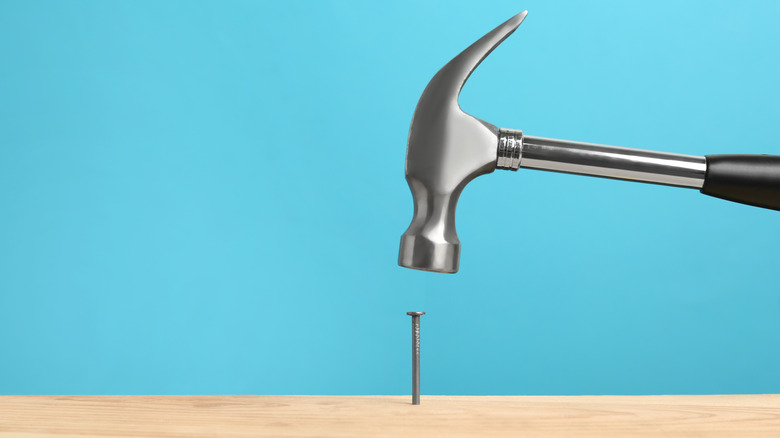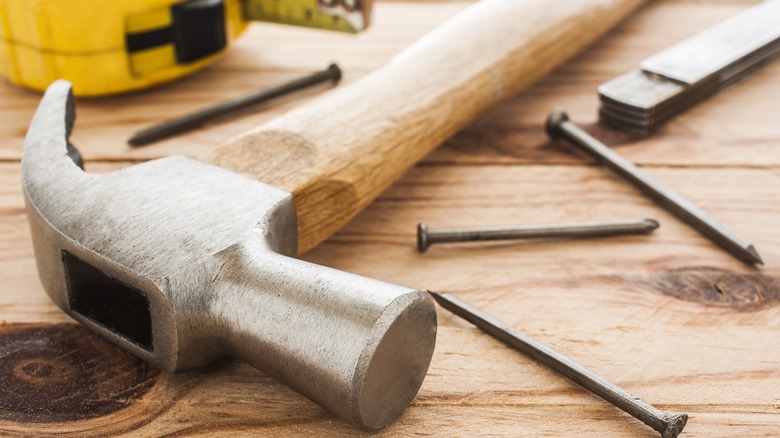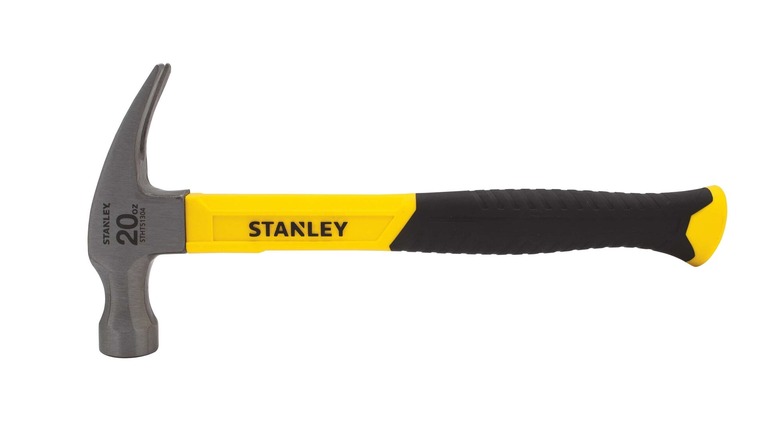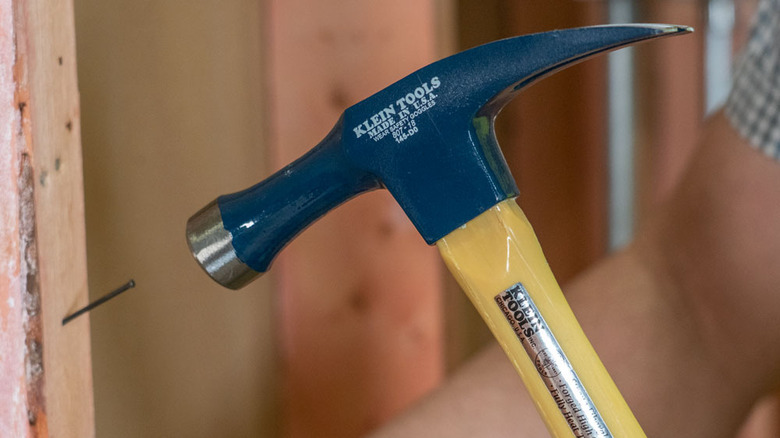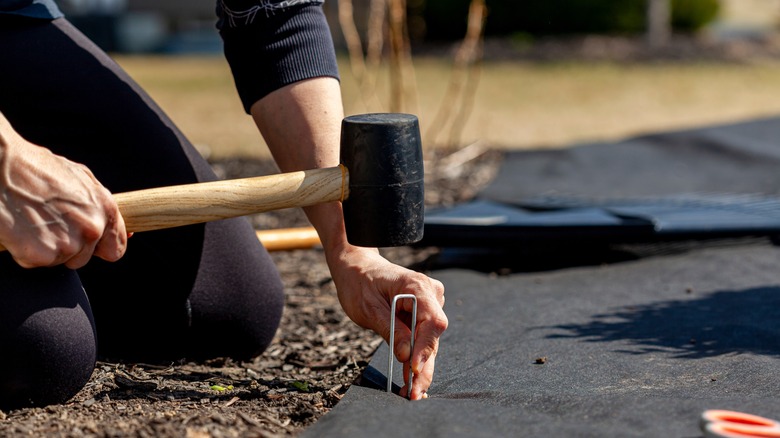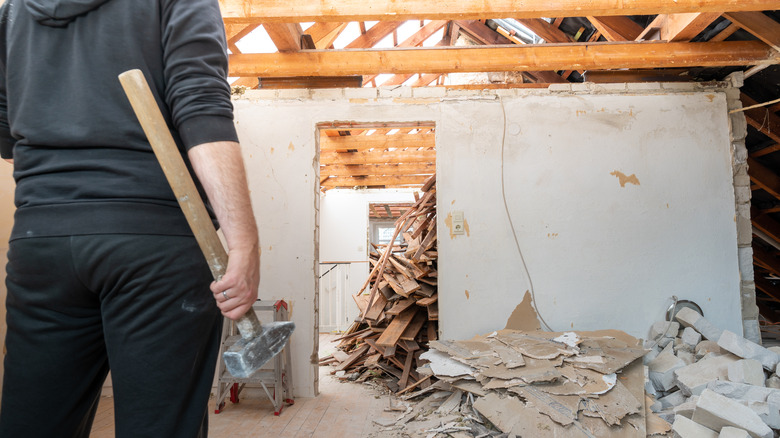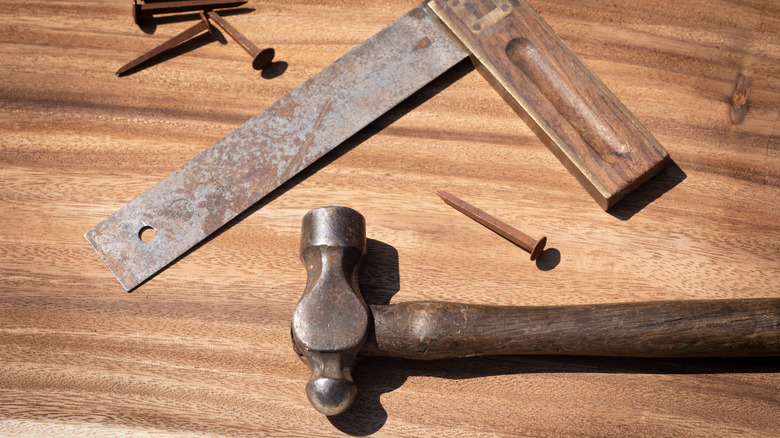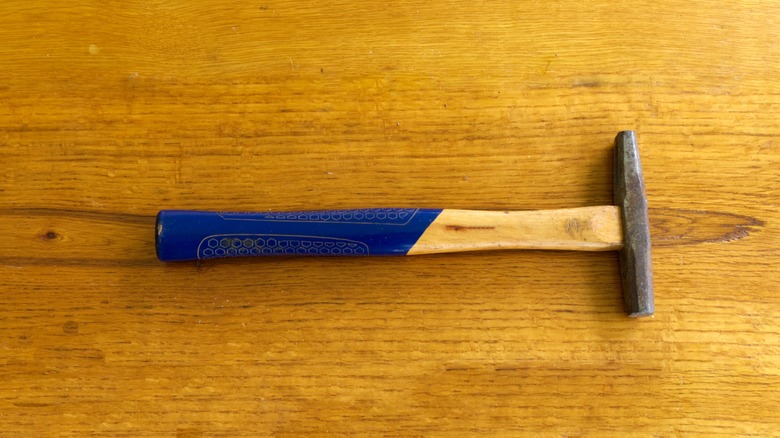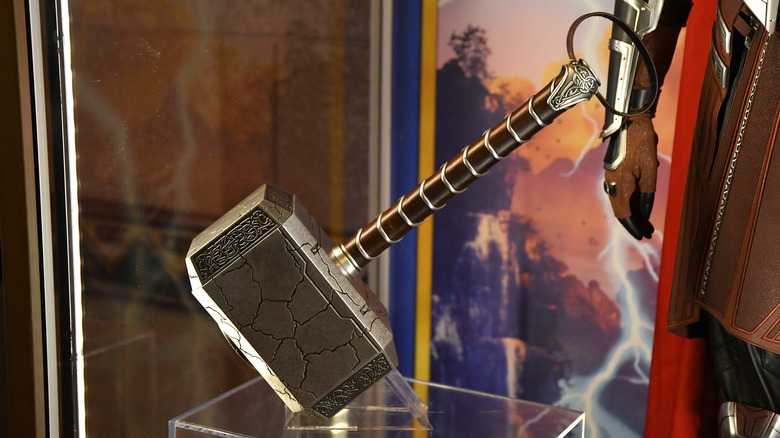8 Hammer Types And When To Use Them
We may receive a commission on purchases made from links.
There is no bad hammer, only the wrong hammer for the job. A hammer is simply a striking tool with a handle and a roughly perpendicular head. It's the simplest sort of tool imaginable, and because of this, there are many variations — about as many as there are things to strike. These uses dictate the customization of every part of a hammer. So if you need to hammer the head of a rivet flat, you won't do it as well or with as much ease as with a ball peen hammer. That's why experts and artisans tend to have a lot of hammers in various shapes and sizes: The right tool for every job.
And despite its simplicity, these craftsmen can wield a hammer with dazzling skill after many years of practice, assuming it's the right one. This is a matter of knowing what length and weight you need, what type of face it should have (textured for grip or smooth), and what should be on the opposite end of the head from the face (usually a peen or claw.) Try to think about hammers according to the sort of stuff you'll be striking: masonry, nails, metal to be formed, wood, etc. And think a little about what else a hammer can do for you as you work. Here are the different types of hammers you can have in your arsenal.
Claw hammers
Picture yourself building a house, a toybox, or a toolbox. What you're probably holding in your mind's eye is a hammer, and it's probably a claw hammer. This is the one truly general-purpose hammer, and if you can only have one hammer in your collection, this is the one you need. (You probably shouldn't only have one hammer, as you'll see below.) Let's look at what makes claw hammers distinct and what makes them indistinct.
The typical claw hammer has a smooth face that balances the ability to strike a nail well without marring the surface you're driving the nail into. Opposite its face is the claw, a split and tapered wedge that's most often used to pull out nails that were driven poorly or need to be removed for any other reason. A jack-of-all-trades claw hammer will be 16 to 20 ounces, and probably at the top of that range if you drive nails with any regularity. The handle might be made of wood, steel, fiberglass, graphite, or more specialized composites and metals.
All the features are important, but the key to a good claw hammer is the claw itself. A well-made claw can slip under nail heads that are nearly flush with the work surface, be sharp enough to grip the nail's shaft rather than its head, and will be tempered well enough that the sharpness isn't temporary.
Framing hammer
The framing hammer is, unsurprisingly, designed specifically for framing the wood walls of houses. It's heavier (20 to 32 oz.) and longer than a claw hammer, and has some other features that make it well-suited for lots of heavy-duty hammering. The face of this tool is usually crosshatched in a way that promotes grip on the nail head, which naturally leads to more nails that are driven in rather than bent over. The split head on the other end (sometimes called a "straight claw") is far less curved than a typical claw hammer. This design provides less leverage than a curved claw when pulling a nail, but it also has some advantages. A straight claw can be used to separate materials, can be used like an ice axe to arrest a fall, and is a great help when driven into a large timber, so the hammer can be used as a carrying handle. And the straight claw will pull nails effectively if you know the tricks.
Handle shape is important for framing hammers. The curved, axe-like design of many framing hammers is more ergonomic for driving lots of nails, preventing the pain and rehabilitation that results from "tennis elbow." And look for a shock-absorbing handle like Stanley's Anti-Vibe Xtreme or Fiskars' IsoCore technologies.
Electrician's hammer
Here's your dose of daily heresy: If you're the sort of casual DIYer who occasionally installs a shelf but would never consider actually making a shelf, an electrician's hammer might be what you need. And it makes a great everyday carry hammer for skilled artisans on the go. Our take on the electrician's hammer is a little different from the common view, as you might have guessed, so let us explain.
The electrician's hammer does a few things better than most claw and framing hammers. It works great in tight spaces because of its slightly smaller size and longer neck. Its size is helpful in working between wall studs, for example, and a longer neck helps it reach into recessed areas more easily. Plus, it's electrically insulated between the face and the grip to keep you from shocking yourself if you accidentally come into contact with a wire-carrying current. Shock absorption is important in an electrician's hammer, but not as critical as it is for framers.
Mallets
Whacking things delicately feels like an oxymoron, but it's the function of many hammers. The ones you probably need most are mallets. You might also need their cousin, the soft-faced hammer, in your arsenal, as well their burly uncle, the dead-blow hammer. These all have some things in common and a few important distinguishing features.
A mallet is a block of plastic, wood, metal, or rubber on a handle, and it keeps you from damaging your work surfaces with misplaced strikes. Mallets are also useful for striking the workpiece directly without marring, as when you're fitting wood joints together or shaping/forming metal. The head of a mallet is usually symmetrical with two equally weighted striking surfaces, though there are round mallet heads such as those used by carvers. Because of this symmetry, mallet handles might have ergonomic features but tend not to have curves that bias the handle for use in a particular direction, the way framing hammer handles do.
A soft-faced hammer is a type of mallet that usually has different materials on each side of the head, often nylon and rubber. These separate "heads" are often removable, so they can be replaced with other heads. For example, this is especially handy when building cabinetry, where a marred surface is nothing short of a disaster. For the average DIYer, a soft-faced hammer is probably the only mallet needed.
A dead-blow hammer is a specialized mallet-like hammer often coated in plastic. Dead-blow hammers transfer a larger percentage of the striking force because they don't waste energy in rebounding. They are specially designed to do it over a longer period, all while protecting the materials being struck.
Sledge hammer
While they have a similar general shape, dead-blow and sledge hammers are near opposite ends of the delicacy spectrum. The sledge is heavy, and long-handled ones are meant for two-handed use. They are used to destroy (as in demolition work or breaking stone) and to drive materials that are difficult and don't require any attention to their final appearance. They might weigh up to 20 pounds and might have handles up to three feet long.
You probably need a sledge hammer, but chances are you don't need the one you'd get at your local Ace Hardware if you ask for one. Most of them are overkill for the work they're bought for. A short-handled, four-pound sledge hammer will probably do just about everything you need, while allowing you to survive the experience. These shorter sledges are sometimes called club hammers or engineer's hammers. Of course, if you find yourself regularly driving railroad spikes in your backyard, a larger sledgehammer might be necessary.
Ball peen hammer
There's an entire universe of tools you don't know you need until you've tried using something else. At the center of that universe is the ball peen hammer. Almost no one knows what they're for, but many people would probably find one useful. While the ball peen hammer shape — a typical flat hammer face on one side and a hemispherical rounded face on the other — is almost as iconic as the claw hammer, most people might know it from popular culture rather than actual handling. "Ball peen hammer" is the dialect Tony Soprano would use to talk to his daughter's abuser, according to Silvio. Or Joe Dirt's claim that "one swing and this here ball-peen hammer will trigger this A-bomb, and it'll blow up the whole city, maybe even half the country." But the magic of the ball peen hammer isn't in its power but in its shape.
This particular shape of peen (the part opposite the usual striking face) was originally used to round off the rolled edge of hand-fastened rivets, typically in heavy steel structures, so that they would grip and not protrude unnecessarily. The peen derives its name from "peening," a cold method of working metal to improve its hardness. So ball-peen hammers are useful for metal conditioning and forming, in which the shape is particularly useful. The average household will find many uses for the harder steel of a ball-peen hammer, from striking cold chisels to driving heavy nails. Or when you smack your mower deck into a raised tree root and need to pound it back into shape, the ball-peen hammer might be the tool for you. Ask us how we know.
Tack hammer
A tack hammer is what you buy your eight-year-old when she wants a hammer, but you don't quite trust her with a 20-ounce framing hammer. Tack hammers have other uses as well, such as hammering tacks. So, umm, what is a tack? It's basically a small nail. As such, they tend to be thin and have small heads, both of which contribute to an unfortunate tendency to bend when struck with an overpowered hammer. Tack hammers are ideal for delivering just enough power in as small an area as is practical. And when you're seating dozens of upholstery tacks, it will be beneficial to swing considerably less weight than the bigger hammers in your toolbox.
Tack hammers (and similar trim hammers) are ideal for more delicate work, like installing trim pieces without marring their surfaces. While tack guns are now used for installing large amounts of trim, chances are the average homeowner won't want the hassle of using one for a small project. Tack hammers are very handy for those moments.
Specialized hammers you might need, and some you definitely don't
You can go into Tractor Supply today and buy a war hammer, which (per the product description) is designed to stun opponents and then be reversed to kill them with a spike through the helmet. Farming has apparently changed since we read about it in children's books. But unless you're a bloodthirsty kale grower, you obviously don't need a war hammer, and big-box home improvements stock dozens of other hammers you don't need either. Let's take a look at what you definitely don't need, unless you do.
We joked about using a sledge hammer to drive railroad spikes, but there's a special hammer called a Railroad-spike maul. You don't need one. You similarly don't need a dental hammer or, in all likelihood, a gavel. And if all goes well, you won't need a chain hammer, typically used to break glass for access to fire alarms. There's a whole universe of chasing, tinner, blocking, planishing, and other metalworking hammers you won't need unless you're into metalworking. These all have face and peen shapes that are highly specialized for their specific purposes, and nothing else will do nearly as well, so if you need one after all, don't try to substitute a less well-suited hammer.
Depending on your habits, you might need a welder or drywall hammer. The same is true for hammers related to other specialized skills, including lineman's, slater's, and blacksmith's hammers. If you need a prospector's hammer, good luck to you!
Hammer brands and prices
While hammers from specialty manufacturers like Snap-On might be a little pricier, and ones from makers like Stiletto are likely to be far pricier, you can generally get a good claw or framing hammer for less than $35 at Amazon or big-box home improvement stores. That includes hammers made by companies known for their hammers, like Estwing and Vaughan. Other manufacturers of quality hammers include Fiskars, Kobalt, Craftsman, Stanley, Milwaukee, Crescent, and DeWalt. It's not difficult to spend $60 on a DeWalt or Milwaukee hammer (or $100 for the cheapest Stiletto), and it's even easier to pay $8 on a bargain model from Stanley or Anvil. In fact, Home Depot sells a key blank that costs more than its cheapest HDX store-brand claw hammer.
Is spending a lot on a top-quality hammer a good idea? If you're a casual DIYer, maybe not. On the one hand, you might choose to use screws or a nail gun instead. On the other, a great hammer's weight, comfort, and ergonomics might be beneficial enough regardless of the price. It's a very individual choice. You probably don't want to break the bank for a hammer based on durability; hammers are likely to be lost before they are worn or damaged significantly, and even the cheap ones will probably last a lifetime.
If you're a pro (or aspire to become one), do yourself a favor and spend the most you can afford on a good hammer. Your body will thank you. And, besides, you'll look silly on a job site with a hammer that looks like, well, a mere hammer rather than some sort of high-tech Mars rover attachment.
